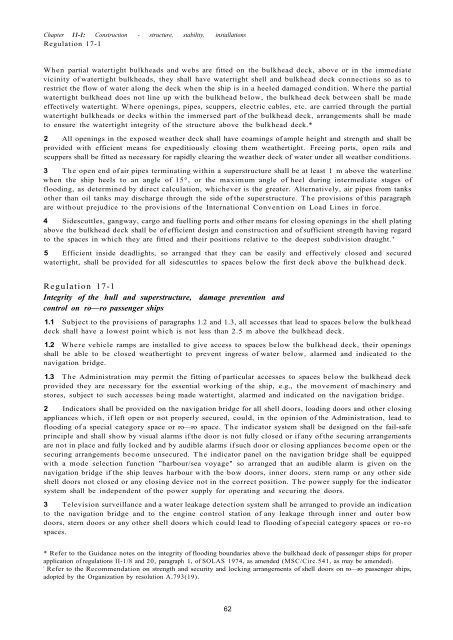Solas Consolidated Edition 2009.pdf
Solas Consolidated Edition 2009 for maritime
Solas Consolidated Edition 2009 for maritime
You also want an ePaper? Increase the reach of your titles
YUMPU automatically turns print PDFs into web optimized ePapers that Google loves.
Chapter 11-1: Construction - structure, stability, installations<br />
Regulation 17-1<br />
When partial watertight bulkheads and webs are fitted on the bulkhead deck, above or in the immediate<br />
vicinity of watertight bulkheads, they shall have watertight shell and bulkhead deck connections so as to<br />
restrict the flow of water along the deck when the ship is in a heeled damaged condition. Where the partial<br />
watertight bulkhead does not line up with the bulkhead below, the bulkhead deck between shall be made<br />
effectively watertight. Where openings, pipes, scuppers, electric cables, etc. are carried through the partial<br />
watertight bulkheads or decks within the immersed part of the bulkhead deck, arrangements shall be made<br />
to ensure the watertight integrity of the structure above the bulkhead deck.*<br />
2 All openings in the exposed weather deck shall have coamings of ample height and strength and shall be<br />
provided with efficient means for expeditiously closing them weathertight. Freeing ports, open rails and<br />
scuppers shall be fitted as necessary for rapidly clearing the weather deck of water under all weather conditions.<br />
3 The open end of air pipes terminating within a superstructure shall be at least 1 m above the waterline<br />
when the ship heels to an angle of 15°, or the maximum angle of heel during intermediate stages of<br />
flooding, as determined by direct calculation, whichever is the greater. Alternatively, air pipes from tanks<br />
other than oil tanks may discharge through the side of the superstructure. The provisions of this paragraph<br />
are without prejudice to the provisions of the International Convention on Load Lines in force.<br />
4 Sidescuttles, gangway, cargo and fuelling ports and other means for closing openings in the shell plating<br />
above the bulkhead deck shall be of efficient design and construction and of sufficient strength having regard<br />
to the spaces in which they are fitted and their positions relative to the deepest subdivision draught. 1 '<br />
5 Efficient inside deadlights, so arranged that they can be easily and effectively closed and secured<br />
watertight, shall be provided for all sidescuttles to spaces below the first deck above the bulkhead deck.<br />
Regulation 17-1<br />
Integrity of the hull and superstructure, damage prevention and<br />
control on ro—ro passenger ships<br />
1.1 Subject to the provisions of paragraphs 1.2 and 1.3, all accesses that lead to spaces below the bulkhead<br />
deck shall have a lowest point which is not less than 2.5 m above the bulkhead deck.<br />
1.2 Where vehicle ramps are installed to give access to spaces below the bulkhead deck, their openings<br />
shall be able to be closed weathertight to prevent ingress of water below, alarmed and indicated to the<br />
navigation bridge.<br />
1.3 The Administration may permit the fitting of particular accesses to spaces below the bulkhead deck<br />
provided they are necessary for the essential working of the ship, e.g., the movement of machinery and<br />
stores, subject to such accesses being made watertight, alarmed and indicated on the navigation bridge.<br />
2 Indicators shall be provided on the navigation bridge for all shell doors, loading doors and other closing<br />
appliances which, if left open or not properly secured, could, in the opinion of the Administration, lead to<br />
flooding of a special category space or ro—ro space. The indicator system shall be designed on the fail-safe<br />
principle and shall show by visual alarms if the door is not fully closed or if any of the securing arrangements<br />
are not in place and fully locked and by audible alarms if such door or closing appliances become open or the<br />
securing arrangements become unsecured. The indicator panel on the navigation bridge shall be equipped<br />
with a mode selection function "harbour/sea voyage" so arranged that an audible alarm is given on the<br />
navigation bridge if the ship leaves harbour with the bow doors, inner doors, stern ramp or any other side<br />
shell doors not closed or any closing device not in the correct position. The power supply for the indicator<br />
system shall be independent of the power supply for operating and securing the doors.<br />
3 Television surveillance and a water leakage detection system shall be arranged to provide an indication<br />
to the navigation bridge and to the engine control station of any leakage through inner and outer bow<br />
doors, stern doors or any other shell doors which could lead to flooding of special category spaces or ro-ro<br />
spaces.<br />
* Refer to the Guidance notes on the integrity of flooding boundaries above the bulkhead deck of passenger ships for proper<br />
application of regulations II-1/8 and 20, paragraph 1, of SOLAS 1974, as amended (MSC/Circ.541, as may be amended).<br />
f<br />
Refer to the Recommendation on strength and security and locking arrangements of shell doors on ro—ro passenger ships,<br />
adopted by the Organization by resolution A.793(19).<br />
62


